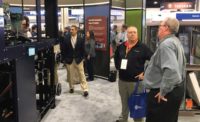“We have expanded very rapidly and are investing in new markets,” said Akinori Atarahi, president of Daikin AC. “We are proud to say that we have achieved the rank of No. 1 globally.” He also stated that Daikin-McQuay did $10.8 billion in sales in 2010.
AHRI CERTIFICATION
There was also much excitement about the implementation of the Air-Conditioning, Heating, and Refrigeration Institute’s (AHRI) new certification program for variable refrigerant flow (VRF) equipment. Standard 1230, Performance Rating of VRF Multi-Split Air Conditioning and Heat Pump Equipment, has been in development since 2005.
“AHRI Standard 1230 will allow VRF manufacturers to rate and test full load, part load, and heat recovery,” said Daikin’s Dominic Kolandayan. “This will reflect true VRF system benefits including part load performance and low ambient heating capabilities. All efficiency values will be based on the total system performance including outdoor unit power input, power input of indoor units, and piping loss correction factors to reflect real life building performance.”
Dave Lucas, vice president of distribution sales for Daikin AC, gave a presentation on the “Technology Adoption Lifecycle” and related it to VRF technology. In this lifecycle, 2 percent of the public are innovators, which mean they have no barriers to adopt new technology. Next, early adopters make up 13 percent of the population. These people also want new technology because they enjoy it and they do not concern themselves with what others say about the technology.
They are followed by the early majority (34 percent), the late majority (35 percent) and the laggards (16 percent; the last guys to get a cell phone). He noted that the largest group in this lifecycle is the late majority — which account for 35 percent of the public.
“There people are conservative by nature, and the product has to have some kind of standard in order for them to buy,” Lucas said. “They do not see the advantage otherwise. If products do not get to the late majority, then they do not have much of a chance. That is why AHRI Standard 1230 is so important. Being a regulated industry, you really need to have those things in place before the mainstream market will let you participate. Up to this point, we were just working with a waiver. With these standards we fall into the same fold as conventional systems do.”
Daikin has seen great growth during the five years it has been in the American market.
“The last few years have really pushed the industry down. What we have right now is we see new technologies coming in. And with the acceptance of standardizations and ratings, there is a real opportunity for a paradigm shift in what consumers are looking for in the value of their a/c, the cost, and the comfort levels in their home,” Lucas said. “We are the new kid on the block still. But we have a thought in the back of our brain where we can start talking about a billion dollars. It is exciting for us.”
NEW PRODUCTS
Daikin also used the meeting to roll out some new products for its distributors. One of these products was the Single Split 20 plus SEER Wall Mount L Series.
“This will solve issues in a house that is poorly performing with hot or cold spots. This also takes advantage of the tax credit tier two scheme and helps reduce electric bills,” said Marc Bellanger, Daikin product manager, residential.
Bellanger also talked about improvements to the Daikin Altherma system. The Altherma is an air/water heat pump.
“It is a unique system that heats, produces domestic hot water, and can even cool spaces. It offers maximum year-round comfort,” Bellanger said.
Daikin Altherma heats through radiant floor technology but now also offers an alternative with a single A-coil configured hydronic heating and cooling operation and an ECM fan motor for improved sound levels and energy savings.
The distributors were allowed to view all these products and more at the trade show during the Daikin meeting.
Publication date: 11/28/2011









